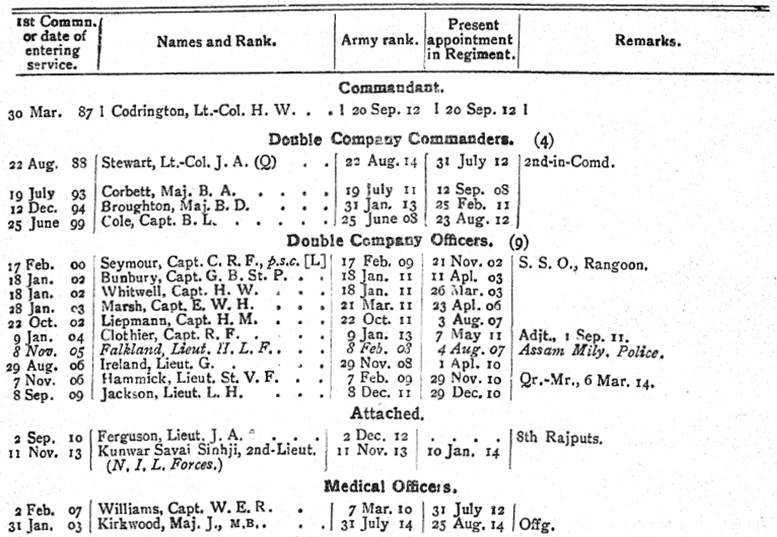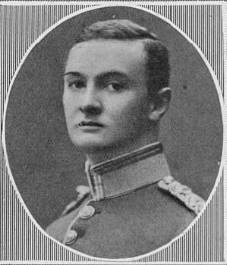This article is about the 13th Rajputs (The Shekhawati Regiment) and will help you to research the Regiment and soldiers who served with it during the First World War. I have also written a series of guides to help you research soldiers who served in the Indian Army during. To view the guides click on the blue link below:
The 13th Rajputs (The Shekhawati Regiment) in the First World War
Lineage: Raised at Shekhawati by Major H. Forster as part of the Shekhawati Brigade (Jaipur Contingent) in 1835 and taken into the East India Companies’ service in 1843. In 1847 it became the Shekhawati Battalion and in 1861 its designation changed twice first to the 14th Regiment of Bengal Native Infantry and then to the 13th Regiment of Bengal Native Infantry. Then the 13th (The Shekhawati) Regiment of Bengal Native Infantry in 1884 and the 13th (The Shekhawati) Regiment of Bengal Infantry in 1885. The Regiment’s designation was changed to the 13th (Shekhawati) Rajput Regiment of Bengal Infantry in 1897 and the 13th (Shekhawati) Rajput Infantry in 1901. In 1903 it became the 13th Rajputs (The Shekhawati Regiment) and the 10th Battalion, 6th Rajputana Rifles (a training battalion) in 1922.
Class Composition of Battalion in 1914: 8 Companies of Rajputana Rajputs. 1919: 4 Companies Rajputana Rajputs.
Location in August 1914: The 13th Rajputs was stationed at Agra (Uttar Pradesh, India), having arrived from Hong Kong on 1st May 1911.
The 13th Rajputs (The Shekhawati Regiment) was an Indian infantry regiment which was mobilized at Agra on 11 September 1914. The Regiment embarked on board SS Pentakota at Bombay (Mumbai) on 7 October 1914 as part of Indian Expeditionary Force B sent to attack German East Africa (Tanzania). The expeditionary force arrived off the port of Tanga, German East Africa on 2 November 1914 and was heavily defeated in the Battle of Tanga between 3 and 5 November. The Regiment landed at Tanga on 3 November and in the course of two days fighting suffered 94 casualties, including 9 British officers. The extract below was taken from the October 1914 Indian Army List and recorded the British officers serving with the 13th Rajputs in the October 1914.
After the defeat at Tanga, the expeditionary force withdrew to British East Africa (Kenya) to reorganize. The East Africa Campaign continued into November 1918 but the 13th Rajputs was withdrawn in either late 1915 or early 1916. The Regiment served on the North West Frontier (Khyber Pakhtunkhwa, Pakistan) after East Africa and when it was mobilized for service in Mesopotamia (Iraq) in July 1917 was stationed at Fort Lockhart. The Regiment disembarked at Basra on 28 July 1917 and served on the Euphrates Defences and Communications for the remainder of the war. The 13th Rajputs remained in Mesopotamia after the war and served as General Headquarters troops during the 1920 Iraqi Revolt. Soldiers of the Regiment who served in Mesopotamia during the Iraqi Revolt qualified for the General Service Medal with Iraq Clasp. Surviving Medal Index Cards for this medal can be viewed on either Ancestry or the National Archives’ website. In 1922, the 13th Rajputs (The Shekhawati Regiment) became the 10th Battalion, 6th Rajputana Rifles which was a training battalion.
Captain Robert Clothier, the 13th Rajputs’ Adjutant who was mortally wounded by a burst of machine gun fire around 8.45 am on 3 November 1914 along with Second-Lieutenant Day. Lieutenant-Colonel Codrington was also severely wounded by the same burst.
War Diaries of the 13th Rajputs (The Shekhawati Regiment)
There are four war diaries for the Regiment and all have been digitized by the National Archives. To download the war diaries for a small fee click on the blue links below. I have transcribed some entries at the bottom of the page.
- Date: 01 September 1914 – 30 November 1915
- General Headquarters, East Africa
- Reference: WO 95/5318/1
- Notes: An excellent war diary, especially detailed in the preparations the 13th Rajputs undertook prior to embarkation to East Africa. The Battle of Tanga is covered in detail and at great length in two appendices written shortly after the battle. There is also a 3-page account by Lieutenant J. A. Ferguson, Brigade Scouts Officer describing the activities of the Brigade Scouts during the battle. Another appendix concerns the activities of the 13th Rajput’s Machine Guns and contains two statements made by Indian soldiers. An appendix containing a list of officers and men recommended for gallantry. Another appendix listing the British Officers with the 13th Rajputs at Tanga and their fates and two maps of Tanga. After Tanga, very little happened (July – August 1915 is a single page), but the war diary is full of names, including Indian rank and file with their regimental number recorded.
- Date: 01 July 1917 – 31 July 1919
- Euphrates Defence and Communications, Headquarters and Troops,
- Reference: WO 95/5028/9
- Notes: A poor war diary which is typical of a unit serving on the lines of communication where not a lot happened. There is a nominal roll of British officers serving with the Regiment at the end of the month from 31 December 1917. The nominal roll for May, August and September 1918 also included Indian officers. There is a copy of an Operation Order for the 3rd Battalion 9th Bhopal Infantry dated 26 May 1919.
- Date: 01 August 1919 – 31 August 1920
- General Headquarters
- Reference: WO 95/5226/2
- Notes: Another poor war diary, though there are a handful of detailed entries during the Iraq Revolt. There is a nominal roll of British officers serving with the Regiment at the end of each month between August 1919 and April 1920.
- Date: 01 September – 31 December 1920
- General Headquarters
- Reference: WO 95/5003/1
- Notes: This is the best war diary for the Regiment’s service in Mesopotamia with many detailed entries.
Further Sources for the 13th Rajputs (The Shekhawati Regiment)
A good source of information for the 13th Rajputs (The Shekhawati Regiment) are its confidential reports held at the British Library: Confidential Reports on Regiments etc. These reports also contain the confidential reports of the British officers who served with the Regiment. Though, when the Regiment was abroad only the Depot and the British officers serving with it were reported on. For information regarding the British and Indian officers who served with the 13th Rajputs, the Indian Army List should be consulted.
Extracts from War Diaries 13th Rajputs (The Shekhawati Regiment)
01 September 1914 – 30 November 1915, East Africa, WO 95/5318/1
16 September 1914 – Captain Cole rejoined from Imperial Service Troops [and] 68 Reservists joined.
25 September 1914 – Received Maxim Gun mules from 99th Infantry. Good mules in excellent condition but quite untrained in any pack work as notified by Officer Commanding 99th Infantry.
2 November 1914 – At Sea Close to Tanga Bay – Orders were received that disembarkation would commence at 4 pm. and that the covering party would consist of the whole of the 13th Rajputs and the Brigade Scouts and that 61st [Pioneers] would land after us. General Tighe’s No.1 operation order to hold good.
2 November 1914 – 10.30 pm- Tanga Bay – The lighters stranded at about 500 yards from the shore. It was found that the water was up to the men’s chest and impossible to land accoutered men.
An enemy’s picquet opened fire on the lighters, which went high and was not continued for more than a few minutes. One maxim returned this fire and H.M.S. Fox fired one shell. Captain Seymour reconnoitered the passage to shore and on his return a landing party of 50 men from each of the two lighters, and the Brigade Scouts went ashore with their rifles and ammunition only. Their advance was unopposed.
3 November 1914 – 2.45 am – The enemy made a slight attack on a picquet on our left about 2.45am. Captain Seymour reported having seen the enemy’s picquet with two maxims on the road to Tanga.
3 November 1914 – 5.40 am – Heavy firing was heard in the direction of Tanga and the remainder of the force available viz 13th Rajputs left 4 Companies : 3 Companies 61st Pioneers and the Brigade Scouts started to reinforce Lieutenant Colonel Stewart’s detachment, with C Company. Advanced guard under Captain Cole on coming into the zone of fire the 13th Rajputs moved up on the left of Lieutenant Colonel Stewart;s party who were then beyond the cemetery and deep ditch about 300 yards from the enemy’s position which appeared to be alone…
8.45 am After advancing to within 400 yards from the Railway embankment at about 8.45am Lieutenant Colonel Codrington (Commandment); Captain Clothier (Adjutant) and 2nd Lieutenant Day were simultaneously wounded by a burst of Maxim fire, the first severely, both the latter mortally. About the same time Major Corbett was severely wounded. The 61st were brought up on our left. The enemy soon after made a counter attack in some force on the left and a retirement commenced from that flank.


